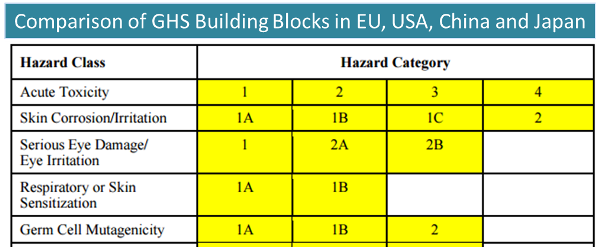Comparison of GHS Building Blocks in EU, USA, China and Japan
Little Pro on 2016-08-02
GHS allows individual countries or competent authorities to choose which GHS hazard classes or hazard categories to implement when GHS is incorporated into their national regulations. For example, EU has not adopted flammable liquids category 4. This approach is often called GHS Building Blocks approach. In this article, we will compare GHS building blocks adopted in EU, USA, China and Japan.
Comparison of GHS Building Blocks
This comparison is made on 2 August 2016 based on the following GHS regulations and standards. The equivalent GHS version has also been given.
- UN GHS Purple Book (2015) - GHS Rev. 6;
- EU CLP Regulation (latest amendment in 2016) - GHS Rev. 5;
- USA OSHA Hazard Communication Standard (2012) - GHS Rev. 3;
- China GB 30000 Classification and Labelling of Chemicals (2013) - GHS Rev. 4;
- Japan JIS 7252 Classification of Chemicals Based on GHS (2014) - GHS Rev.4;
| GHS Hazard Classes (Rev. 6) | Europe | USA | China | Japan |
|---|---|---|---|---|
| Explosives, unstable/1.1/1.2/1.3/1.4/1.5/1.6 | Y | Y | Y | Y |
| Flammable gases category 1, 2 | Y | Y | Y | Y |
| Pyrophoric gases category 1 | N | Y | N | N |
| Chemically unstable gases category A/B | Y | N | Y | Y |
| Aerosols category 1 and 2 (Flammable) | Y | Y | Y | Y |
| Aerosols category 3 (Unflammable) | Y | N | Y | Y |
| Oxidizing gases category 1 | Y | Y | Y | Y |
| Gases under pressure | Y | Y | Y | Y |
| Flammable liquids, category 1, 2, 3 | Y | Y | Y | Y |
| Flammable liquids, category 4 | N | Y | Y | Y |
| Flammable solids category 1, 2 | Y | Y | Y | Y |
| Self-reactive substances, Type A,B,C,D,E,F,G | Y | Y | Y | Y |
| Pyrophoric solids category 1 | Y | Y | Y | Y |
| Pyrophoric liquids category 1 | Y | Y | Y | Y |
| Self-heating substances and mixtures, category 1, 2 | Y | Y | Y | Y |
| Substances which on contact with water emit flammable gases category 1, 2, 3 | Y | Y | Y | Y |
| Oxidizing liquids category 1, 2, 3 | Y | Y | Y | Y |
| Oxidizing solids category 1, 2, 3 | Y | Y | Y | Y |
| Organic peroxides type A,B,C,D,E,F,G | Y | Y | Y | Y |
| Corrosive to metals category 1 | Y | Y | Y | Y |
| Desensitized explosives category 1,2,3,4 | N | N | N | N |
| Acute toxicity category 1, 2, 3,4 | Y | Y | Y | Y |
| Acute toxicity category 5 | N | N | Y | N |
| Skin irritation/corrosion category 1A/1B/1C/2 | Y | Y | Y | Y |
| Skin irritation/corrosion category 3 | N | N | Y | N |
| Serious eye damage/eye irritation category 1/2(2A/2B) | Y | Y | Y | Y |
| Respiratory or skin sensitization category 1A/1B | Y | Y | Y | Y |
| Germ cell mutagenicity category 1A/1B/2 | Y | Y | Y | Y |
| Carcinogenicity category 1A/1B/2 | Y | Y | Y | Y |
| Reproductive toxicity category 1A/1B/2/EFFECTS ON OR VIA LACTATION | Y | Y | Y | Y |
| Target organ systemic toxicity - single exposure category 1, 2 and 3 | Y | Y | Y | Y |
| Target organ systemic toxicity - repeated exposure category 1 and 2 | Y | Y | Y | Y |
| Aspiration toxicity category 1 | Y | Y | Y | Y |
| Aspiration toxicity category 2 | N | N | Y | N |
| Hazardous to aquatic environment (acute) category 1 | Y | Not required | Y | Y |
| Hazardous to aquatic environment (acute) category 2 and 3 | N | Not required | Y | Y |
| Hazardous to aquatic environment (chronic) category 1 and 2 | Y | Not required | Y | Y |
| Hazardous to aquatic environment (chronic) category 3 and 4 | Y | Not required | Y | Y |
| Hazardous to the Ozone layer | Y | Not required | Y | Y |
It should be noted that there are additional hazard categories for simple asphyxiants and combustible dust in the US. In Europe, there are also some supplementary hazard classes which are not included in the GHS.

Reference
- GHS classification criteria from UN GHS rev. 6
- Consolidated EU CLP regulation with amendment.
- OSHA guidance on chemical classification
- GHS implementation in Europe
- GHS implementation in USA
- GHS implementation in China
- GHS implementation in Japan
Having Questions?
We do not provide consultancy services. If you have questions or need any help, please contact our sponsor. You may also find an expert in CSP business directory below. If you are a consultant, you may get yourself listed in CSP business directory (free) or sponsor this page to leave your contact info on this page..

Tags: Topics - GHS, GHS Basics and Tutorials